Cross-Cultural Analysis of Marketing Techniques in the 21st Century
VerifiedAdded on 2023/01/19
|7
|2033
|96
Report
AI Summary
This report provides a comprehensive analysis of cross-cultural marketing, focusing on the relevance of traditional frameworks like Hofstede's cultural dimensions, Hall's Iceberg Concept, and Trompenaars' cross-cultural analysis in the 21st century. The report begins with an introduction to cross-cultural analysis, emphasizing its significance in global marketing. It then critically evaluates each of the mentioned models, discussing their strengths, weaknesses, and practical applications. The evaluation includes a comparison of the models, highlighting their key differences and similarities in understanding cultural nuances. The report concludes by assessing the continued relevance of these traditional techniques in the modern era of globalization and technological advancements, arguing that they remain essential for businesses aiming to develop effective marketing strategies and achieve success in diverse international markets. The analysis includes examples of how these models can be applied to understand cultural differences and adapt marketing strategies accordingly. The report also mentions how failure to understand cultural aspects could lead to loss of monetary resources for the company.
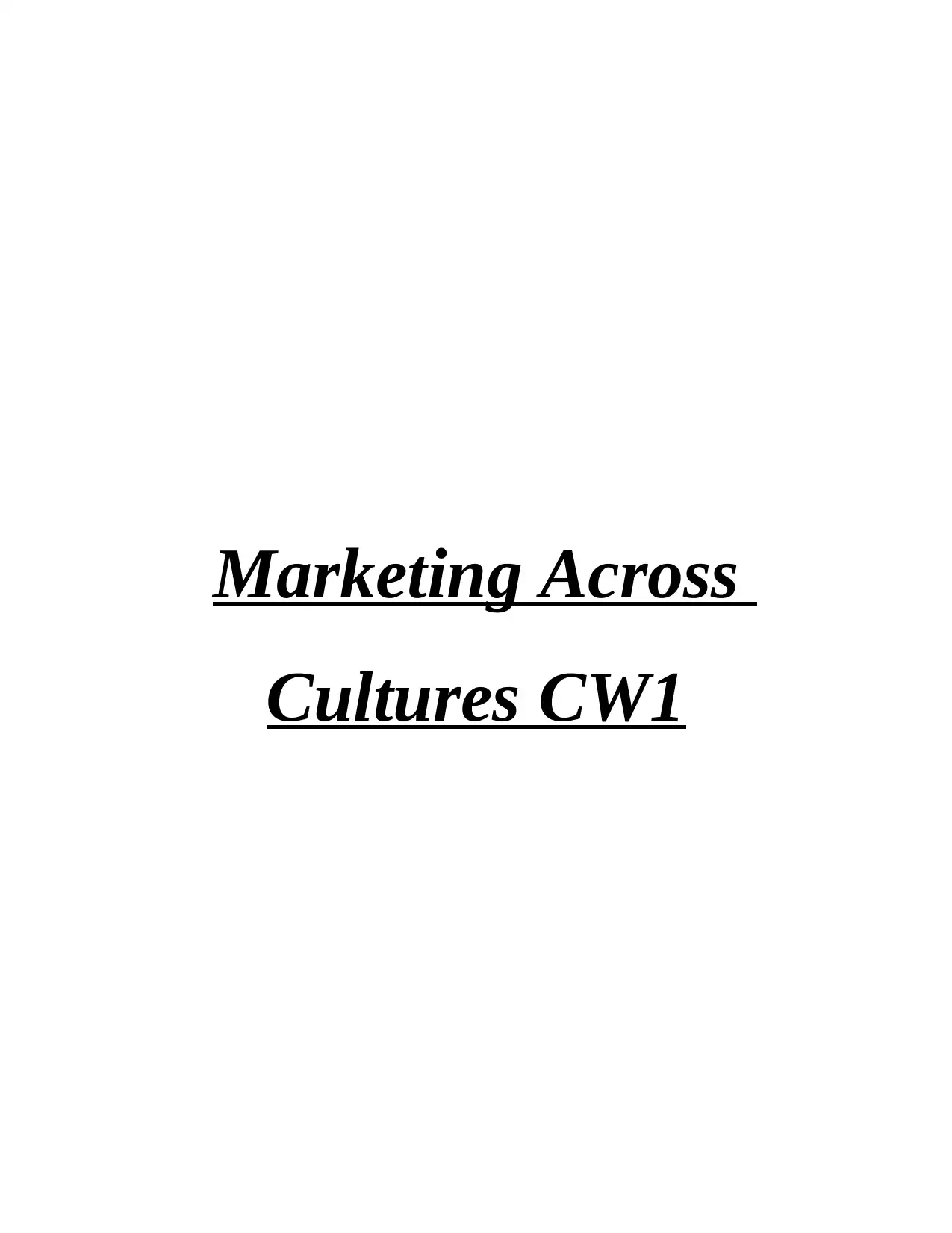
Marketing Across
Cultures CW1
Cultures CW1
Paraphrase This Document
Need a fresh take? Get an instant paraphrase of this document with our AI Paraphraser
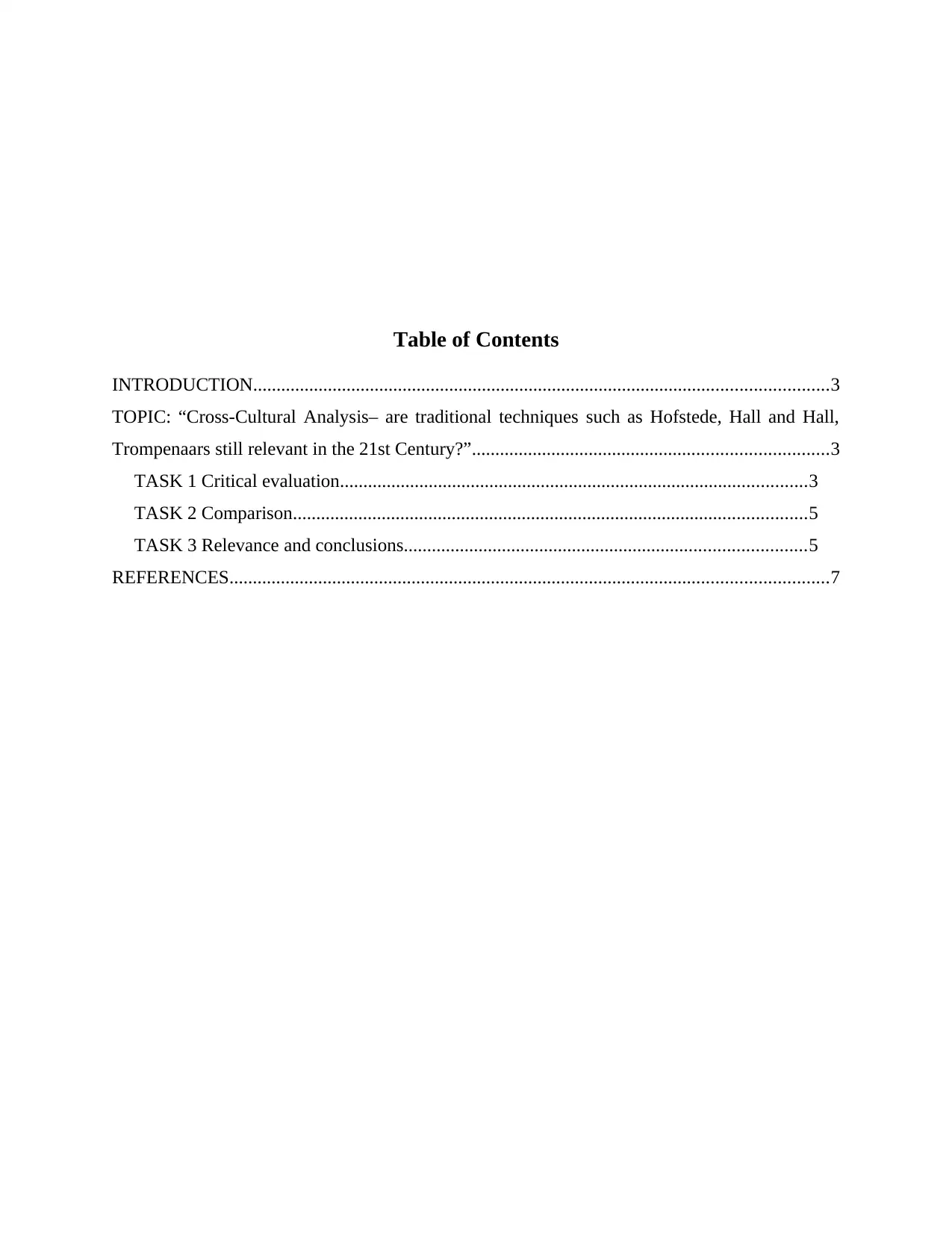
Table of Contents
INTRODUCTION...........................................................................................................................3
TOPIC: “Cross-Cultural Analysis– are traditional techniques such as Hofstede, Hall and Hall,
Trompenaars still relevant in the 21st Century?”............................................................................3
TASK 1 Critical evaluation....................................................................................................3
TASK 2 Comparison..............................................................................................................5
TASK 3 Relevance and conclusions......................................................................................5
REFERENCES................................................................................................................................7
INTRODUCTION...........................................................................................................................3
TOPIC: “Cross-Cultural Analysis– are traditional techniques such as Hofstede, Hall and Hall,
Trompenaars still relevant in the 21st Century?”............................................................................3
TASK 1 Critical evaluation....................................................................................................3
TASK 2 Comparison..............................................................................................................5
TASK 3 Relevance and conclusions......................................................................................5
REFERENCES................................................................................................................................7
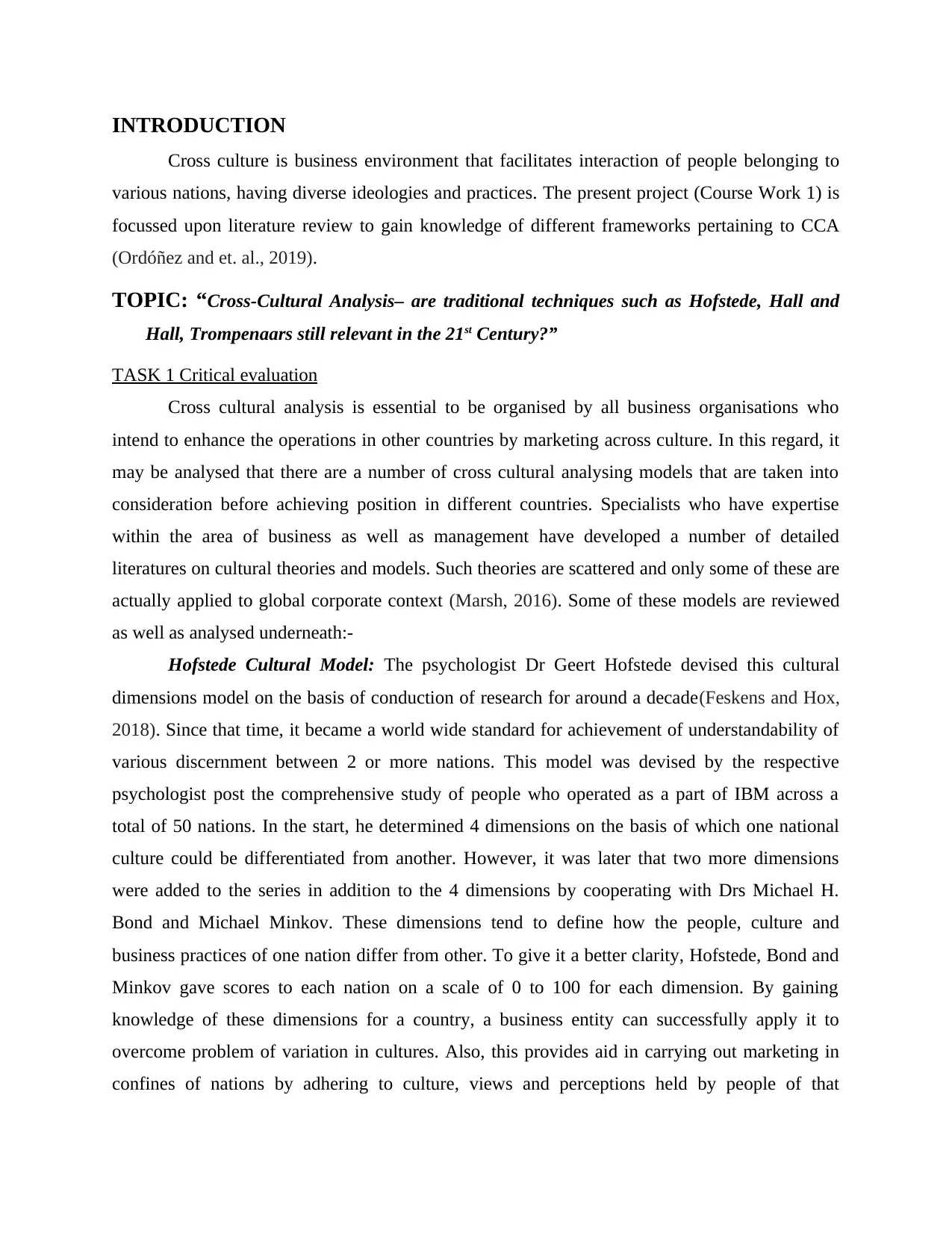
INTRODUCTION
Cross culture is business environment that facilitates interaction of people belonging to
various nations, having diverse ideologies and practices. The present project (Course Work 1) is
focussed upon literature review to gain knowledge of different frameworks pertaining to CCA
(Ordóñez and et. al., 2019).
TOPIC: “Cross-Cultural Analysis– are traditional techniques such as Hofstede, Hall and
Hall, Trompenaars still relevant in the 21st Century?”
TASK 1 Critical evaluation
Cross cultural analysis is essential to be organised by all business organisations who
intend to enhance the operations in other countries by marketing across culture. In this regard, it
may be analysed that there are a number of cross cultural analysing models that are taken into
consideration before achieving position in different countries. Specialists who have expertise
within the area of business as well as management have developed a number of detailed
literatures on cultural theories and models. Such theories are scattered and only some of these are
actually applied to global corporate context (Marsh, 2016). Some of these models are reviewed
as well as analysed underneath:-
Hofstede Cultural Model: The psychologist Dr Geert Hofstede devised this cultural
dimensions model on the basis of conduction of research for around a decade(Feskens and Hox,
2018). Since that time, it became a world wide standard for achievement of understandability of
various discernment between 2 or more nations. This model was devised by the respective
psychologist post the comprehensive study of people who operated as a part of IBM across a
total of 50 nations. In the start, he determined 4 dimensions on the basis of which one national
culture could be differentiated from another. However, it was later that two more dimensions
were added to the series in addition to the 4 dimensions by cooperating with Drs Michael H.
Bond and Michael Minkov. These dimensions tend to define how the people, culture and
business practices of one nation differ from other. To give it a better clarity, Hofstede, Bond and
Minkov gave scores to each nation on a scale of 0 to 100 for each dimension. By gaining
knowledge of these dimensions for a country, a business entity can successfully apply it to
overcome problem of variation in cultures. Also, this provides aid in carrying out marketing in
confines of nations by adhering to culture, views and perceptions held by people of that
Cross culture is business environment that facilitates interaction of people belonging to
various nations, having diverse ideologies and practices. The present project (Course Work 1) is
focussed upon literature review to gain knowledge of different frameworks pertaining to CCA
(Ordóñez and et. al., 2019).
TOPIC: “Cross-Cultural Analysis– are traditional techniques such as Hofstede, Hall and
Hall, Trompenaars still relevant in the 21st Century?”
TASK 1 Critical evaluation
Cross cultural analysis is essential to be organised by all business organisations who
intend to enhance the operations in other countries by marketing across culture. In this regard, it
may be analysed that there are a number of cross cultural analysing models that are taken into
consideration before achieving position in different countries. Specialists who have expertise
within the area of business as well as management have developed a number of detailed
literatures on cultural theories and models. Such theories are scattered and only some of these are
actually applied to global corporate context (Marsh, 2016). Some of these models are reviewed
as well as analysed underneath:-
Hofstede Cultural Model: The psychologist Dr Geert Hofstede devised this cultural
dimensions model on the basis of conduction of research for around a decade(Feskens and Hox,
2018). Since that time, it became a world wide standard for achievement of understandability of
various discernment between 2 or more nations. This model was devised by the respective
psychologist post the comprehensive study of people who operated as a part of IBM across a
total of 50 nations. In the start, he determined 4 dimensions on the basis of which one national
culture could be differentiated from another. However, it was later that two more dimensions
were added to the series in addition to the 4 dimensions by cooperating with Drs Michael H.
Bond and Michael Minkov. These dimensions tend to define how the people, culture and
business practices of one nation differ from other. To give it a better clarity, Hofstede, Bond and
Minkov gave scores to each nation on a scale of 0 to 100 for each dimension. By gaining
knowledge of these dimensions for a country, a business entity can successfully apply it to
overcome problem of variation in cultures. Also, this provides aid in carrying out marketing in
confines of nations by adhering to culture, views and perceptions held by people of that
⊘ This is a preview!⊘
Do you want full access?
Subscribe today to unlock all pages.

Trusted by 1+ million students worldwide
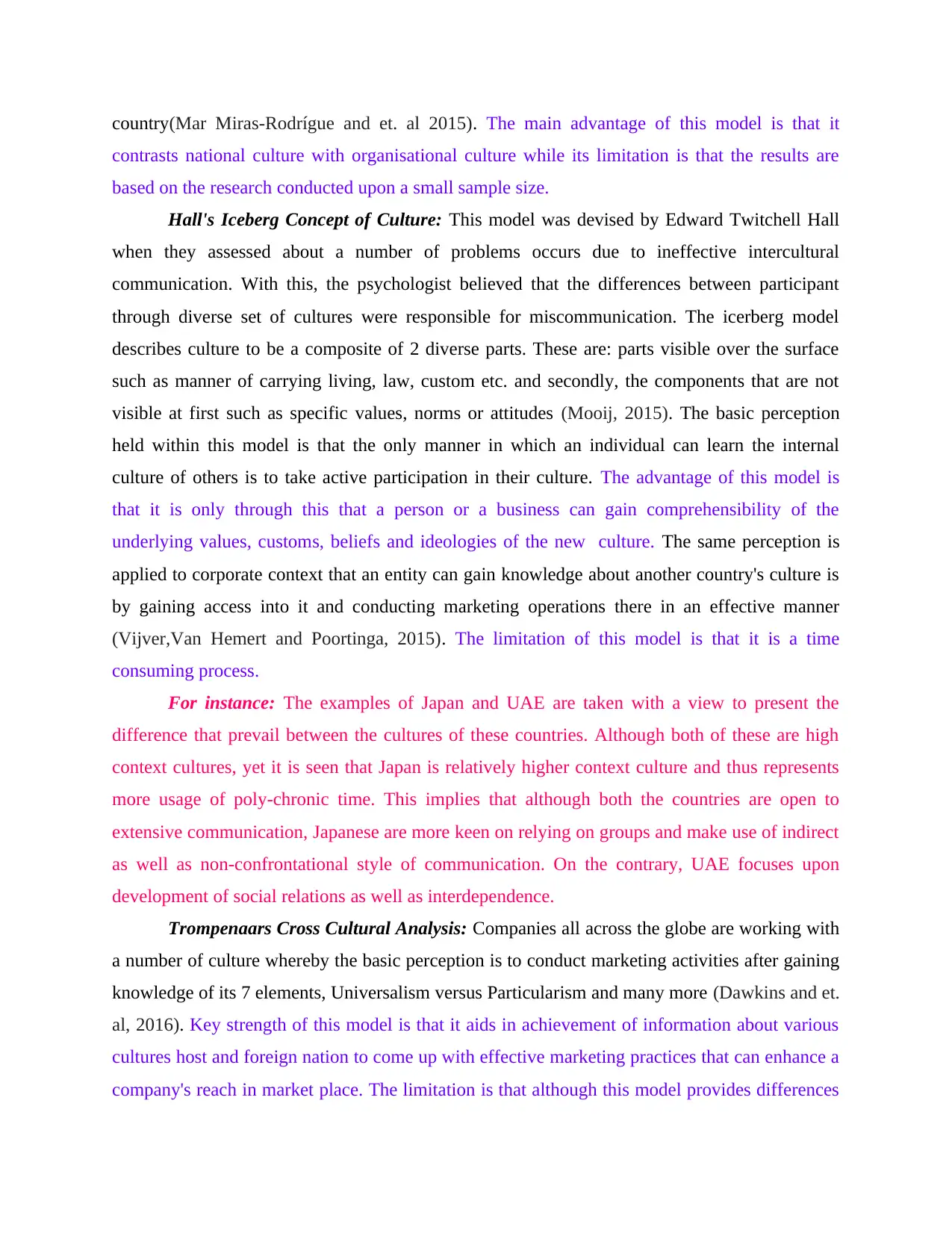
country(Mar Miras‐Rodrígue and et. al 2015). The main advantage of this model is that it
contrasts national culture with organisational culture while its limitation is that the results are
based on the research conducted upon a small sample size.
Hall's Iceberg Concept of Culture: This model was devised by Edward Twitchell Hall
when they assessed about a number of problems occurs due to ineffective intercultural
communication. With this, the psychologist believed that the differences between participant
through diverse set of cultures were responsible for miscommunication. The icerberg model
describes culture to be a composite of 2 diverse parts. These are: parts visible over the surface
such as manner of carrying living, law, custom etc. and secondly, the components that are not
visible at first such as specific values, norms or attitudes (Mooij, 2015). The basic perception
held within this model is that the only manner in which an individual can learn the internal
culture of others is to take active participation in their culture. The advantage of this model is
that it is only through this that a person or a business can gain comprehensibility of the
underlying values, customs, beliefs and ideologies of the new culture. The same perception is
applied to corporate context that an entity can gain knowledge about another country's culture is
by gaining access into it and conducting marketing operations there in an effective manner
(Vijver,Van Hemert and Poortinga, 2015). The limitation of this model is that it is a time
consuming process.
For instance: The examples of Japan and UAE are taken with a view to present the
difference that prevail between the cultures of these countries. Although both of these are high
context cultures, yet it is seen that Japan is relatively higher context culture and thus represents
more usage of poly-chronic time. This implies that although both the countries are open to
extensive communication, Japanese are more keen on relying on groups and make use of indirect
as well as non-confrontational style of communication. On the contrary, UAE focuses upon
development of social relations as well as interdependence.
Trompenaars Cross Cultural Analysis: Companies all across the globe are working with
a number of culture whereby the basic perception is to conduct marketing activities after gaining
knowledge of its 7 elements, Universalism versus Particularism and many more (Dawkins and et.
al, 2016). Key strength of this model is that it aids in achievement of information about various
cultures host and foreign nation to come up with effective marketing practices that can enhance a
company's reach in market place. The limitation is that although this model provides differences
contrasts national culture with organisational culture while its limitation is that the results are
based on the research conducted upon a small sample size.
Hall's Iceberg Concept of Culture: This model was devised by Edward Twitchell Hall
when they assessed about a number of problems occurs due to ineffective intercultural
communication. With this, the psychologist believed that the differences between participant
through diverse set of cultures were responsible for miscommunication. The icerberg model
describes culture to be a composite of 2 diverse parts. These are: parts visible over the surface
such as manner of carrying living, law, custom etc. and secondly, the components that are not
visible at first such as specific values, norms or attitudes (Mooij, 2015). The basic perception
held within this model is that the only manner in which an individual can learn the internal
culture of others is to take active participation in their culture. The advantage of this model is
that it is only through this that a person or a business can gain comprehensibility of the
underlying values, customs, beliefs and ideologies of the new culture. The same perception is
applied to corporate context that an entity can gain knowledge about another country's culture is
by gaining access into it and conducting marketing operations there in an effective manner
(Vijver,Van Hemert and Poortinga, 2015). The limitation of this model is that it is a time
consuming process.
For instance: The examples of Japan and UAE are taken with a view to present the
difference that prevail between the cultures of these countries. Although both of these are high
context cultures, yet it is seen that Japan is relatively higher context culture and thus represents
more usage of poly-chronic time. This implies that although both the countries are open to
extensive communication, Japanese are more keen on relying on groups and make use of indirect
as well as non-confrontational style of communication. On the contrary, UAE focuses upon
development of social relations as well as interdependence.
Trompenaars Cross Cultural Analysis: Companies all across the globe are working with
a number of culture whereby the basic perception is to conduct marketing activities after gaining
knowledge of its 7 elements, Universalism versus Particularism and many more (Dawkins and et.
al, 2016). Key strength of this model is that it aids in achievement of information about various
cultures host and foreign nation to come up with effective marketing practices that can enhance a
company's reach in market place. The limitation is that although this model provides differences
Paraphrase This Document
Need a fresh take? Get an instant paraphrase of this document with our AI Paraphraser
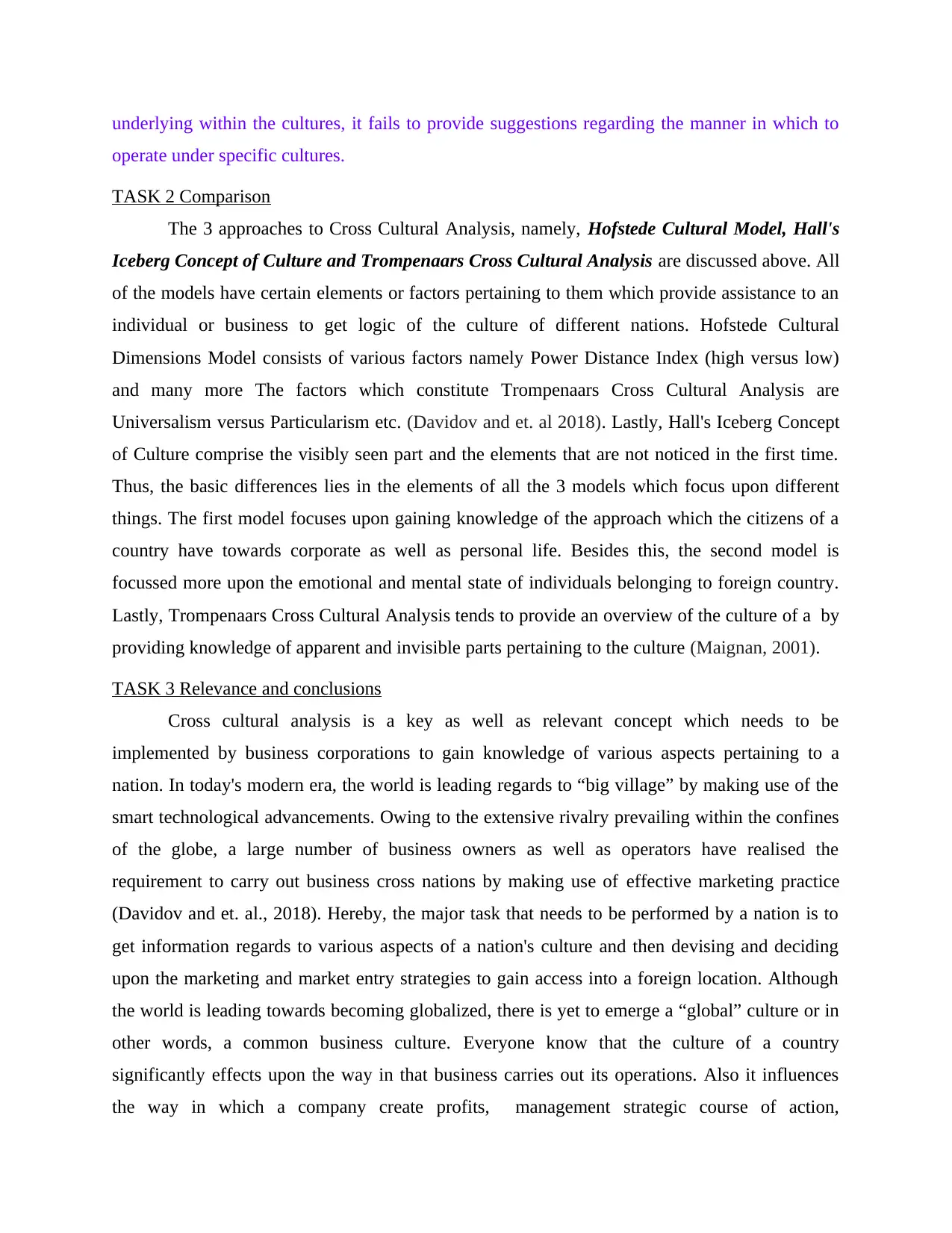
underlying within the cultures, it fails to provide suggestions regarding the manner in which to
operate under specific cultures.
TASK 2 Comparison
The 3 approaches to Cross Cultural Analysis, namely, Hofstede Cultural Model, Hall's
Iceberg Concept of Culture and Trompenaars Cross Cultural Analysis are discussed above. All
of the models have certain elements or factors pertaining to them which provide assistance to an
individual or business to get logic of the culture of different nations. Hofstede Cultural
Dimensions Model consists of various factors namely Power Distance Index (high versus low)
and many more The factors which constitute Trompenaars Cross Cultural Analysis are
Universalism versus Particularism etc. (Davidov and et. al 2018). Lastly, Hall's Iceberg Concept
of Culture comprise the visibly seen part and the elements that are not noticed in the first time.
Thus, the basic differences lies in the elements of all the 3 models which focus upon different
things. The first model focuses upon gaining knowledge of the approach which the citizens of a
country have towards corporate as well as personal life. Besides this, the second model is
focussed more upon the emotional and mental state of individuals belonging to foreign country.
Lastly, Trompenaars Cross Cultural Analysis tends to provide an overview of the culture of a by
providing knowledge of apparent and invisible parts pertaining to the culture (Maignan, 2001).
TASK 3 Relevance and conclusions
Cross cultural analysis is a key as well as relevant concept which needs to be
implemented by business corporations to gain knowledge of various aspects pertaining to a
nation. In today's modern era, the world is leading regards to “big village” by making use of the
smart technological advancements. Owing to the extensive rivalry prevailing within the confines
of the globe, a large number of business owners as well as operators have realised the
requirement to carry out business cross nations by making use of effective marketing practice
(Davidov and et. al., 2018). Hereby, the major task that needs to be performed by a nation is to
get information regards to various aspects of a nation's culture and then devising and deciding
upon the marketing and market entry strategies to gain access into a foreign location. Although
the world is leading towards becoming globalized, there is yet to emerge a “global” culture or in
other words, a common business culture. Everyone know that the culture of a country
significantly effects upon the way in that business carries out its operations. Also it influences
the way in which a company create profits, management strategic course of action,
operate under specific cultures.
TASK 2 Comparison
The 3 approaches to Cross Cultural Analysis, namely, Hofstede Cultural Model, Hall's
Iceberg Concept of Culture and Trompenaars Cross Cultural Analysis are discussed above. All
of the models have certain elements or factors pertaining to them which provide assistance to an
individual or business to get logic of the culture of different nations. Hofstede Cultural
Dimensions Model consists of various factors namely Power Distance Index (high versus low)
and many more The factors which constitute Trompenaars Cross Cultural Analysis are
Universalism versus Particularism etc. (Davidov and et. al 2018). Lastly, Hall's Iceberg Concept
of Culture comprise the visibly seen part and the elements that are not noticed in the first time.
Thus, the basic differences lies in the elements of all the 3 models which focus upon different
things. The first model focuses upon gaining knowledge of the approach which the citizens of a
country have towards corporate as well as personal life. Besides this, the second model is
focussed more upon the emotional and mental state of individuals belonging to foreign country.
Lastly, Trompenaars Cross Cultural Analysis tends to provide an overview of the culture of a by
providing knowledge of apparent and invisible parts pertaining to the culture (Maignan, 2001).
TASK 3 Relevance and conclusions
Cross cultural analysis is a key as well as relevant concept which needs to be
implemented by business corporations to gain knowledge of various aspects pertaining to a
nation. In today's modern era, the world is leading regards to “big village” by making use of the
smart technological advancements. Owing to the extensive rivalry prevailing within the confines
of the globe, a large number of business owners as well as operators have realised the
requirement to carry out business cross nations by making use of effective marketing practice
(Davidov and et. al., 2018). Hereby, the major task that needs to be performed by a nation is to
get information regards to various aspects of a nation's culture and then devising and deciding
upon the marketing and market entry strategies to gain access into a foreign location. Although
the world is leading towards becoming globalized, there is yet to emerge a “global” culture or in
other words, a common business culture. Everyone know that the culture of a country
significantly effects upon the way in that business carries out its operations. Also it influences
the way in which a company create profits, management strategic course of action,
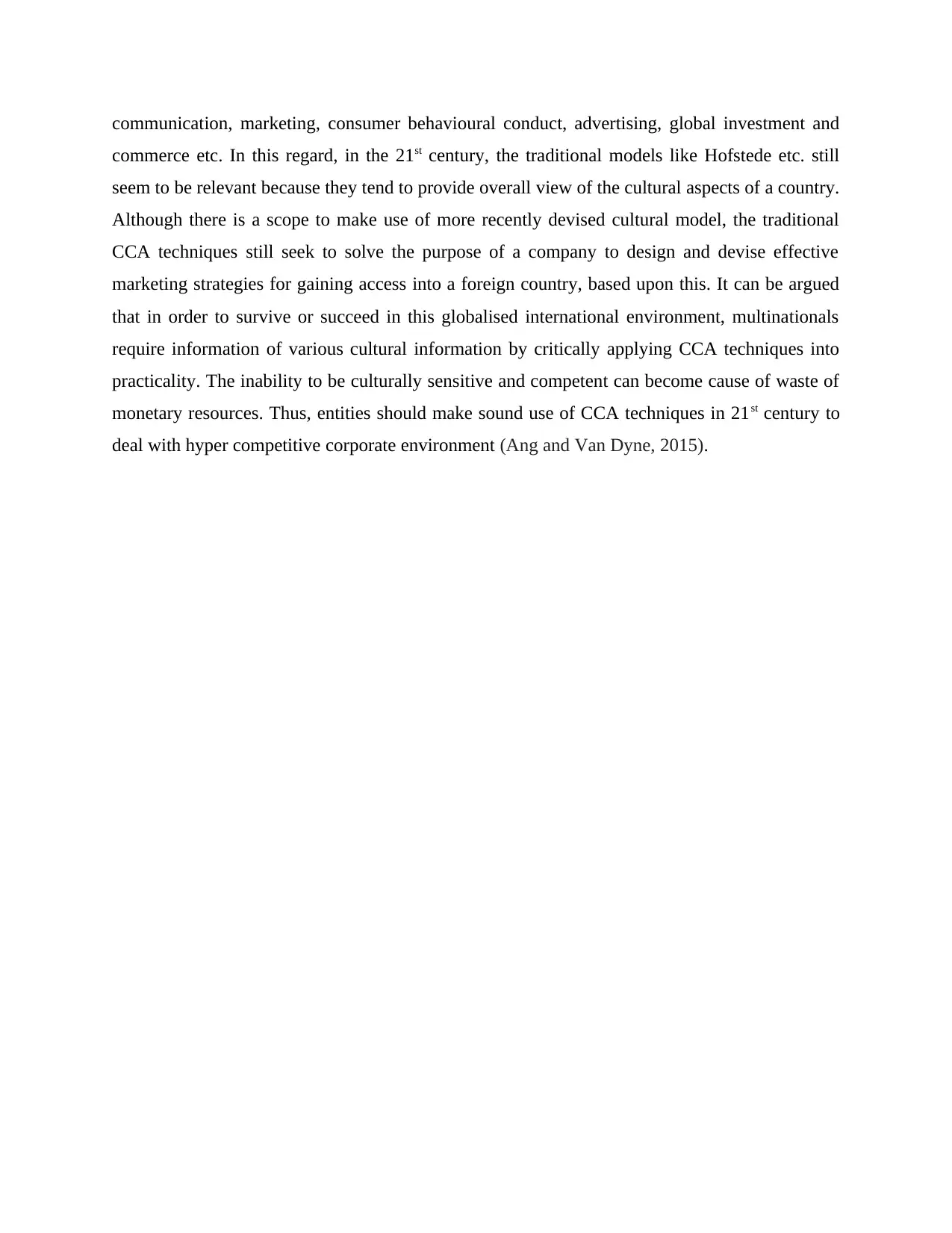
communication, marketing, consumer behavioural conduct, advertising, global investment and
commerce etc. In this regard, in the 21st century, the traditional models like Hofstede etc. still
seem to be relevant because they tend to provide overall view of the cultural aspects of a country.
Although there is a scope to make use of more recently devised cultural model, the traditional
CCA techniques still seek to solve the purpose of a company to design and devise effective
marketing strategies for gaining access into a foreign country, based upon this. It can be argued
that in order to survive or succeed in this globalised international environment, multinationals
require information of various cultural information by critically applying CCA techniques into
practicality. The inability to be culturally sensitive and competent can become cause of waste of
monetary resources. Thus, entities should make sound use of CCA techniques in 21st century to
deal with hyper competitive corporate environment (Ang and Van Dyne, 2015).
commerce etc. In this regard, in the 21st century, the traditional models like Hofstede etc. still
seem to be relevant because they tend to provide overall view of the cultural aspects of a country.
Although there is a scope to make use of more recently devised cultural model, the traditional
CCA techniques still seek to solve the purpose of a company to design and devise effective
marketing strategies for gaining access into a foreign country, based upon this. It can be argued
that in order to survive or succeed in this globalised international environment, multinationals
require information of various cultural information by critically applying CCA techniques into
practicality. The inability to be culturally sensitive and competent can become cause of waste of
monetary resources. Thus, entities should make sound use of CCA techniques in 21st century to
deal with hyper competitive corporate environment (Ang and Van Dyne, 2015).
⊘ This is a preview!⊘
Do you want full access?
Subscribe today to unlock all pages.

Trusted by 1+ million students worldwide
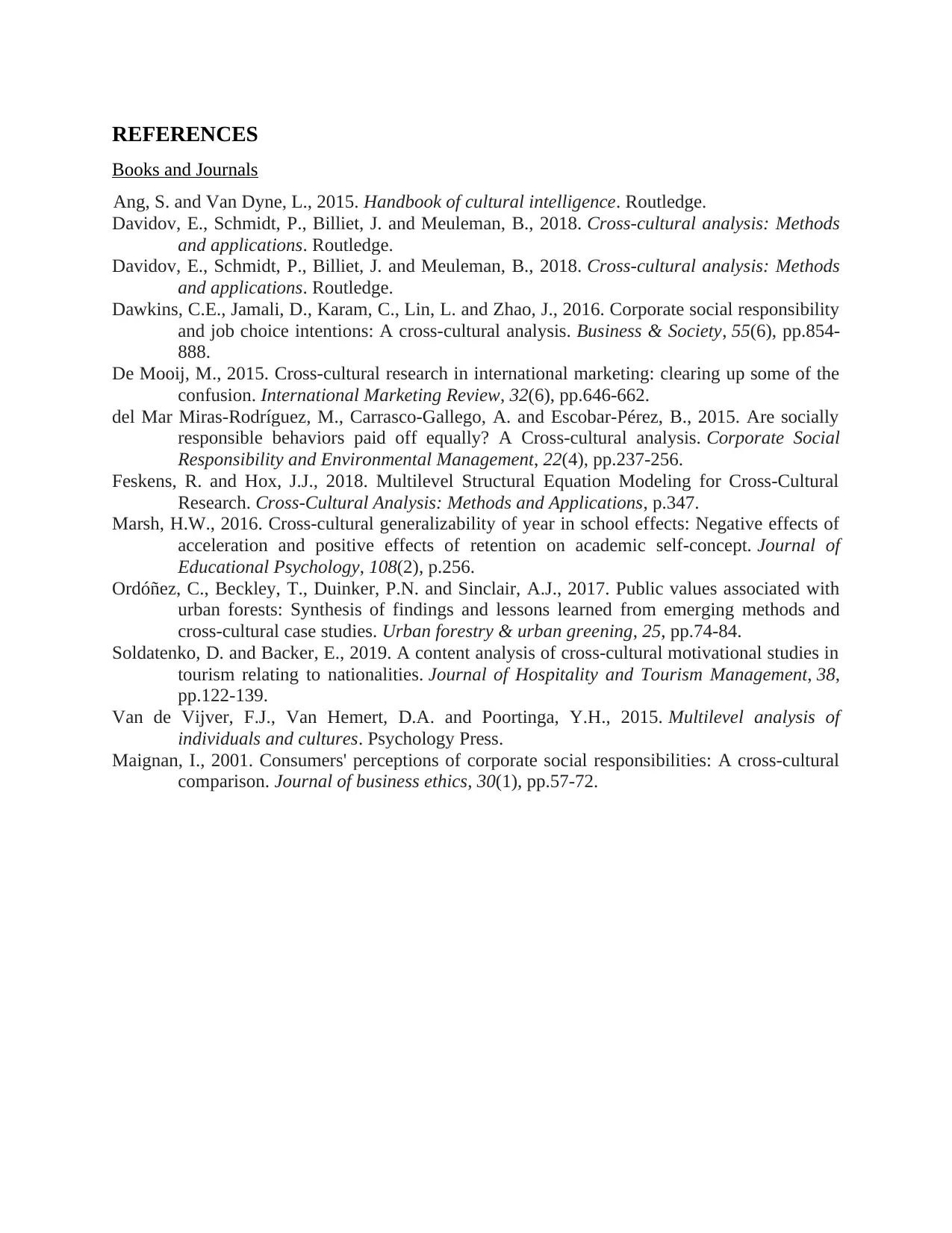
REFERENCES
Books and Journals
Ang, S. and Van Dyne, L., 2015. Handbook of cultural intelligence. Routledge.
Davidov, E., Schmidt, P., Billiet, J. and Meuleman, B., 2018. Cross-cultural analysis: Methods
and applications. Routledge.
Davidov, E., Schmidt, P., Billiet, J. and Meuleman, B., 2018. Cross-cultural analysis: Methods
and applications. Routledge.
Dawkins, C.E., Jamali, D., Karam, C., Lin, L. and Zhao, J., 2016. Corporate social responsibility
and job choice intentions: A cross-cultural analysis. Business & Society, 55(6), pp.854-
888.
De Mooij, M., 2015. Cross-cultural research in international marketing: clearing up some of the
confusion. International Marketing Review, 32(6), pp.646-662.
del Mar Miras‐Rodríguez, M., Carrasco‐Gallego, A. and Escobar‐Pérez, B., 2015. Are socially
responsible behaviors paid off equally? A Cross‐cultural analysis. Corporate Social
Responsibility and Environmental Management, 22(4), pp.237-256.
Feskens, R. and Hox, J.J., 2018. Multilevel Structural Equation Modeling for Cross-Cultural
Research. Cross-Cultural Analysis: Methods and Applications, p.347.
Marsh, H.W., 2016. Cross-cultural generalizability of year in school effects: Negative effects of
acceleration and positive effects of retention on academic self-concept. Journal of
Educational Psychology, 108(2), p.256.
Ordóñez, C., Beckley, T., Duinker, P.N. and Sinclair, A.J., 2017. Public values associated with
urban forests: Synthesis of findings and lessons learned from emerging methods and
cross-cultural case studies. Urban forestry & urban greening, 25, pp.74-84.
Soldatenko, D. and Backer, E., 2019. A content analysis of cross-cultural motivational studies in
tourism relating to nationalities. Journal of Hospitality and Tourism Management, 38,
pp.122-139.
Van de Vijver, F.J., Van Hemert, D.A. and Poortinga, Y.H., 2015. Multilevel analysis of
individuals and cultures. Psychology Press.
Maignan, I., 2001. Consumers' perceptions of corporate social responsibilities: A cross-cultural
comparison. Journal of business ethics, 30(1), pp.57-72.
Books and Journals
Ang, S. and Van Dyne, L., 2015. Handbook of cultural intelligence. Routledge.
Davidov, E., Schmidt, P., Billiet, J. and Meuleman, B., 2018. Cross-cultural analysis: Methods
and applications. Routledge.
Davidov, E., Schmidt, P., Billiet, J. and Meuleman, B., 2018. Cross-cultural analysis: Methods
and applications. Routledge.
Dawkins, C.E., Jamali, D., Karam, C., Lin, L. and Zhao, J., 2016. Corporate social responsibility
and job choice intentions: A cross-cultural analysis. Business & Society, 55(6), pp.854-
888.
De Mooij, M., 2015. Cross-cultural research in international marketing: clearing up some of the
confusion. International Marketing Review, 32(6), pp.646-662.
del Mar Miras‐Rodríguez, M., Carrasco‐Gallego, A. and Escobar‐Pérez, B., 2015. Are socially
responsible behaviors paid off equally? A Cross‐cultural analysis. Corporate Social
Responsibility and Environmental Management, 22(4), pp.237-256.
Feskens, R. and Hox, J.J., 2018. Multilevel Structural Equation Modeling for Cross-Cultural
Research. Cross-Cultural Analysis: Methods and Applications, p.347.
Marsh, H.W., 2016. Cross-cultural generalizability of year in school effects: Negative effects of
acceleration and positive effects of retention on academic self-concept. Journal of
Educational Psychology, 108(2), p.256.
Ordóñez, C., Beckley, T., Duinker, P.N. and Sinclair, A.J., 2017. Public values associated with
urban forests: Synthesis of findings and lessons learned from emerging methods and
cross-cultural case studies. Urban forestry & urban greening, 25, pp.74-84.
Soldatenko, D. and Backer, E., 2019. A content analysis of cross-cultural motivational studies in
tourism relating to nationalities. Journal of Hospitality and Tourism Management, 38,
pp.122-139.
Van de Vijver, F.J., Van Hemert, D.A. and Poortinga, Y.H., 2015. Multilevel analysis of
individuals and cultures. Psychology Press.
Maignan, I., 2001. Consumers' perceptions of corporate social responsibilities: A cross-cultural
comparison. Journal of business ethics, 30(1), pp.57-72.
1 out of 7
Related Documents
Your All-in-One AI-Powered Toolkit for Academic Success.
+13062052269
info@desklib.com
Available 24*7 on WhatsApp / Email
![[object Object]](/_next/static/media/star-bottom.7253800d.svg)
Unlock your academic potential
Copyright © 2020–2025 A2Z Services. All Rights Reserved. Developed and managed by ZUCOL.





